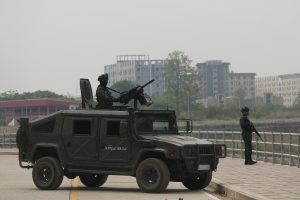MAE SOT — Speculation is mounting that Myanmar’s military junta will launch a counter-offensive aimed at retaking swathes of territory in the east of the country that was lost to anti-regime forces over six months of heavy fighting and includes control of almost all of its borders.
But time is not on the military’s side with the annual monsoons due within weeks. Soldiers on all sides of the conflict share one intense dislike: fighting amid the heavy rains that flood the country between June and the end of October.
Ethnic armed organizations (EAOs) and the anti-junta People’s Defense Forces (PDFs) waited until the dry season before launching their last offensive in October, culminating in the encirclement of the Irrawaddy Basin and the Yangon-Naypyidaw-Mandalay axis.
Their stunning success changed the military dynamics and blew away any lingering thoughts that the junta could win this conflict, and so Senior Gen. Min Aung Hlaing must retake the east if he is to save face and restore some confidence among his embattled troops.
The focus is on Kayin (Karen) State and in particular the town of Myawaddy, the country’s busiest border crossing with Thailand, through which more than a billion dollars in trade passes each year.
Estimates vary, but most sources say about a thousand troops have been dispatched from Yangon, about 400 kilometers to the west, but have failed three times in their attempts to cross the Dawna Mountain Range via established tracks that can be used to ferry supplies for an assault on Myawaddy Township.
“They are using fighter jets and they are throwing all their weapons at it but they still cannot cross the mountains. Until they can take that range they can’t take Myawaddy,” said a PDF source.
“About 100 junta soldiers have been killed. Another 50 have been wounded over the last month but only important officers have been evacuated to Yangon, the rest make do in overcrowded local hospitals or are being treated in the field,” she said.
Separate EAO-PDF sources said battle-hardened troops are being deployed into the east where the junta still has a toehold in strategic areas, including the Infantry Battalion 275 base about 14 kilometers west of Myawaddy and around Shwe Kokko, 20 kilometers to the north.
That might not be enough but more troops could be deployed if a Chinese-brokered ceasefire between the junta and the Arakan Army, fighting in western Rakhine state, is agreed to. At least one source said that could happen within the next two weeks.
Nevertheless, the Karen National Liberation Army (KNLA) is in a commanding position and controls about 90 percent of Kayin State. Yet despite this Myawaddy is problematic and a source of irritation for troops on the ground.
No sooner had the KNLA taken the city of 200,000 people than it abruptly backed down and did a deal with defecting junta soldiers and the local Border Guard Force (BGF) in what amounted to an uneasy power-sharing agreement in mid-April. Some called it a strategic withdrawal.
KNLA leaders and the shadow National Unity Government (NUG) did fear Myawaddy would be mercilessly bombed by the junta’s air force. An uneasy truce still exists, amid pressure from Thailand, but this has upset the rank and file who have little to show for months of hard fighting.
“There’s something wrong. It’s too quiet. We were told in training; in war be true to yourself. We did this and fought but now we feel betrayed by the politicians. I am from Myawaddy, we won that battle and I can’t even go there,” a KNLA commando told this journalist in Mae Sot.
Nevertheless, he indicated the KNLA is braced for a counter-offensive, adding: “The political situation is complex and we can’t talk about the situation or the operations.”
Mae Sot sits on the Thai side of the border opposite Myawaddy, divided by the Moei River and is every bit a frontier town, or halfway house for troops from all sides of the conflict, refugees, and NGOs attempting to meet the needs of hundreds of thousands of people who have fled Myanmar’s conflicts over the years.
And none of them want to get bogged down in the sodden mud, the steep ravines prone to landslides, or thick jungles that are difficult to navigate amid the torrential rains, where delivering supplies, deploying troops, and evacuating the wounded is almost impossible.
This was another reason why the 20-odd EAOs and the PDFs decided not to press home the advantage by attacking Naypyidaw, Yangon, and Mandalay towards the end of April and why many are saying the junta simply does not have the time to retake the east.
But not everyone agrees, as one observer, who declined to be named, put it: “Hlaing is embarrassed and the revolution is succeeding. He desperately needs a win and even in a monsoon, jets can keep bombing and I think the military will still battle it out for control of the road network,” the observer said.
“It might be difficult on the ground but I don’t think the fighting will stop for the wet season,” he added. “In fact, it could intensify because the junta has no choice.”

































